Super blue blood moon phenomenon on Jan 31

KUALA LUMPUR: On Jan 31, the people in Malaysia will have the opportunity to witness a spectacular combination of three lunar phenomena dubbed the Super Blue Blood Moon, a total lunar eclipse which last occurred 152 years ago.
The Super Blue Blood Moon phenomenon, which was last observed on March 31, 1866, is a combination of Supermoon, Bluemoon and Bloodmoon phenomena, according to a statement issued by the National Planetarium to Bernama today.
The statement said the Supermoon phenomenon occurred when a full moon was at the nearest position to Earth in its orbit making it appeared larger than normal.
The Bluemoon phenomenon is the full moon phase that takes place on the same date, which is the second full moon phase in January 2018.
"The eclipse phase of the moon will begin at 7.48pm until 11.11pm and the total lunar eclipse will begin at 8.51pm before reaching its maximum phase at 9.29pm and end at 10.07pm.
"Generally, the lunar eclipse is also known as Bloodmoon as the moon appears reddish after light from the sun is filtered through Earth's atmosphere," the statement said.
If the weather permits, the ideal locations to observe the rare phenomenon are from coastal areas facing the sea on the east side, hilltop areas, highlands, on top of tall buildings or anywhere with an unobstructed view of the sky on the east.
Members of the public are also welcomed to take part in the Super Blue Blood Moon observation programme to be held on Jan 31, 2018 from 7pm til midnight at the entrance of the National Planetarium.
Several telescopes will be provided by the National Planetarium for the lunar eclipse observation purpose in addition to briefing on the phenomenon, astro-photography activities as well as performing lunar eclipse prayers.
For more information, the public can contact the National Planetarium at 03-22735484 or email at info@planet.gov.my or check on the website at www.planetariumnegara.gov.my and Facebook Planetarium Negara.
Meanwhile, the National Space Agency (Angkasa) in a statement today said the total lunar eclipse phenomenon would be visible in eastern Europe, east Africa, Asia (including Malaysia), Australia and North America.
"The lunar eclipse phenomenon will last for five hours and 17 minutes from 6.51pm to 12.08am on Feb 1. This means that the eclipse is taking place when the moon is rising in the east (except for Sabah and Sarawak which will begin after moon rises)," it said.
The Langkawi National Observatory will also hold observation activities to provide the opportunity for the public to observe the phenomenon.
Other observation decks that can be visited for the activities are in Teluk Kemang, Port Dickson, Negri Sembilan; Sungai Lang Parit Baru, Sungai Ayer Tawar, Selangor; Tanjung Bidara, Malacca; Pantai Tok Jembal, Terengganu; Tun Mustapha Tower, Kota Kinabalu, Sabah; and Kampung Kubang Rawa, Salor, Kelantan. — Bernama